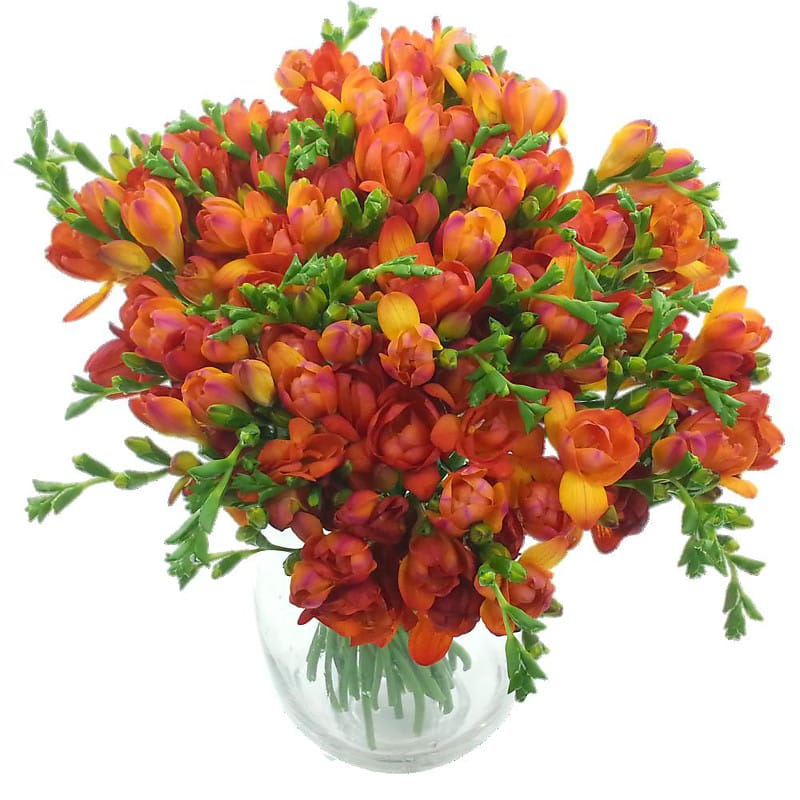
Freesia is a genus of herbaceous perennial flowering crops in the family Iridaceae, first referred to as a genus in 1866 by Chr. Fr. Echlon (1795-1868) and named after German botanist and doctor Friedrich Freese (1794-1878). It really is indigenous to the eastern part of southern Africa, from Kenya south to South Africa, most types being within Cape Provinces. Types of the previous genus Anomatheca are actually contained in Freesia. The plant life commonly known as "freesias", with fragrant funnel-shaped flowers, are cultivated hybrids of lots of Freesia species. Some other types are also produced as ornamental plant life.
These are herbaceous plants which expand from a conical corm 1-2.5 cm diameter, which transmits up a tuft of slim leaves 10-30 cm long, and a sparsely branched stem 10-40 cm large bearing a few leaves and a loose one-sided spike of plants with six tepals. Many varieties have fragrant narrowly funnel-shaped flowers, although those formerly located in the genus Anomatheca, such as F. laxa, have flat flowers. Freesias are being used as food crops by the larvae of some Lepidoptera species including Large Yellowish Underwing.
CULTIVATION AND USES
The plants usually called "freesias" derive from crosses made in the 19th hundred years between F. refracta and F. leichtlinii. Numerous cultivars have been bred from these types and the red- and yellow-flowered varieties of F. corymbosa. Modern tetraploid cultivars have blooms ranging from white to yellowish, pink, red and blue-mauve. These are mostly cultivated appropriately in holland by about 80 growers.[3] Freesias can be readily increased from seed. Due to their specific and pleasing scent, they are generally used in hands ointments, shampoos, candles, etc.[citation needed], however, the bouquets are mainly used in wedding bouquets. They could be planted in the fall season in USDA Hardiness Zones 9-10 (i.e. where the temperature does not fall season below about -7 ?C (20 ?F)), and in the planting season in Zones 4-8.
Freesia laxa (previously called Lapeirousia laxa or Anomatheca cruenta) is one of the other species of the genus which is often cultivated. Smaller than the scented freesia cultivars, it offers flat alternatively than cup-shaped blooms. Extensive 'forcing' of the bulb occurs in two Moon Bay in California where several growers chill the light bulbs in proprietary solutions to satisfy frigid dormancy which results in creation of buds inside a predicted number of weeks - often 5 weeks at 55 ?F (13 ?C).
Herbaceous plant life (in botanical use frequently simply herbal products) are crops that have no prolonged woody stem above earth. Herbaceous plants may be annuals, biennials or perennials. Total annual herbaceous plants expire completely by the end of the growing season or when they may have flowered and fruited, and they then expand again from seed. Herbaceous perennial and biennial plant life may have stems that die by the end of the growing season, but elements of the plant survive under or near the bottom from season to season (for biennials, before next growing season, when they flower and expire). New development builds up from living cells staying on or under the ground, including root base, a caudex (a thickened part of the stem at walk out) or various types of underground stems, such as lights, corms, stolons, rhizomes and tubers. Types of herbaceous biennials include carrot, parsnip and common ragwort; herbaceous perennials include potato, peony, hosta, mint, most ferns & most grasses. By contrast, non-herbaceous perennial crops are woody plant life that have stems above earth that stay alive through the dormant season and grow shoots the next 12 months from the above-ground parts - included in these are trees, shrubs and vines.
Valentines Day › Valentine39;s Day Flowers › Dutch Freesia Bouquet
freesia bouquet anniversary flowers
Red Meadows Freesia Bouquet Deluxe Freesia flower bouquet express

